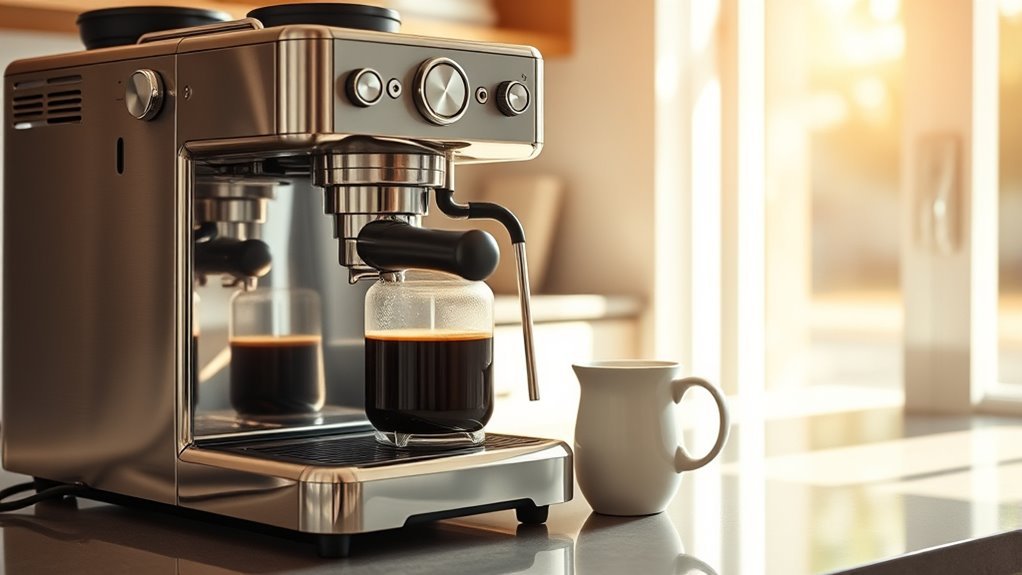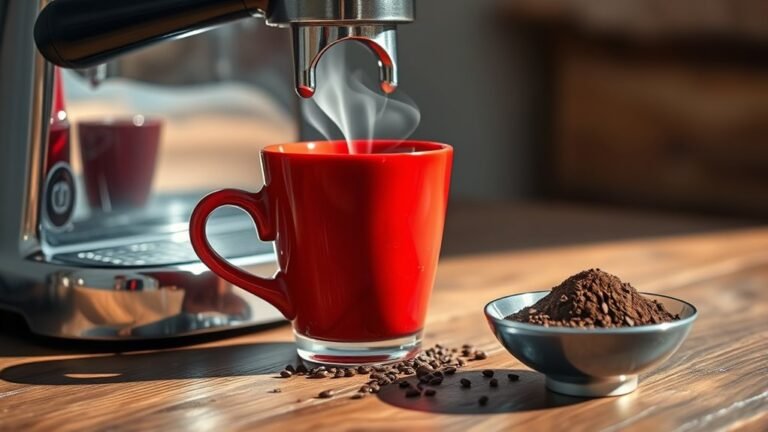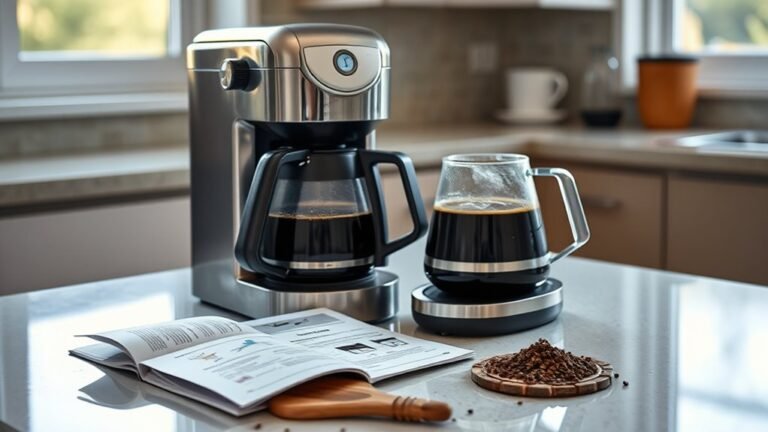Can You Make Regular Coffee in an Espresso Machine
Yes, you can make regular coffee in an espresso machine. To do this, you’ll need to adjust the grind size to a coarser texture and change the water-to-coffee ratio, usually around 1:15. Brew at the right temperature, between 195°F and 205°F, for ideal extraction. Familiarizing yourself with the machine’s settings is vital for achieving the desired flavor profile. If you’re keen on enhancing your coffee experience further, there are more techniques to explore.
Understanding the Espresso Machine’s Functionality
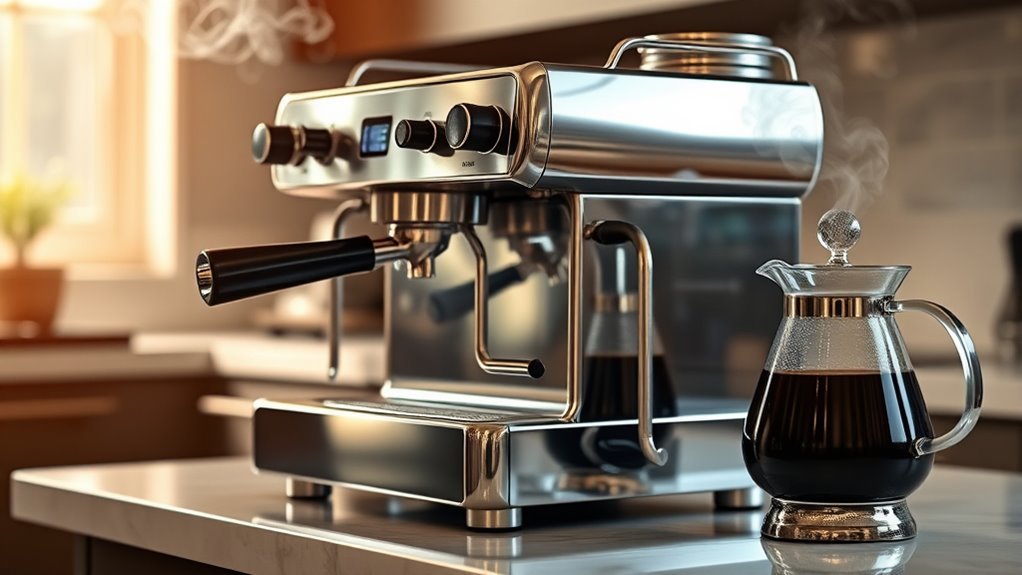
To grasp how to make regular coffee in an espresso machine, it’s essential to understand the machine’s functionality. The mechanics of an espresso machine involve high pressure and temperature to extract coffee efficiently. Unlike traditional brewing, which relies on gravity, espresso machines utilize a pump to force hot water through finely ground coffee, maximizing flavor extraction. Understanding these coffee extraction methods is vital for adapting the espresso machine to produce regular coffee. You’ll need to adjust grind size and water volume to achieve a less concentrated brew. Familiarity with the machine’s settings allows for greater freedom in customizing your coffee experience, ensuring that even in an espresso machine, you can savor the broader flavors of a regular cup of coffee.
The Differences Between Espresso and Regular Coffee
When you compare espresso to regular coffee, the brewing processes highlight key differences. Espresso is made by forcing hot water through finely-ground coffee under pressure, while regular coffee typically uses a drip or immersion method. These variations not only affect the extraction time but also result in distinct flavor profiles that cater to different preferences.
Brewing Process Variations
Although espresso and regular coffee may seem similar at first glance, their brewing processes reveal significant differences that affect flavor, strength, and texture. The variations in brewing techniques highlight how each method impacts coffee extraction.
- Espresso relies on high pressure and a short brewing time, creating a concentrated shot.
- Regular coffee uses gravity and longer steeping, resulting in a milder flavor profile.
- The grind size differs, with espresso requiring a fine grind and regular coffee benefiting from a coarser texture.
These distinctions not only influence the final beverage but also dictate how you might approach using an espresso machine for regular coffee. Understanding these brewing process variations can empower you to experiment and achieve your preferred cup.
Flavor Profile Differences
While both espresso and regular coffee originate from the same bean, their flavor profiles differ markedly due to variations in brewing methods and extraction techniques. Espresso offers a concentrated burst of flavor nuances, often characterized by rich, bold notes and a velvety texture. The high-pressure extraction method emphasizes the coffee’s natural oils, intensifying its sweetness and complexity. In contrast, regular coffee typically showcases a lighter body with more pronounced aroma differences, allowing for a broader range of flavors to emerge. The longer brewing time and coarser grind result in a milder taste, which can highlight fruitier or floral notes. Ultimately, the choice between espresso and regular coffee comes down to personal preference for these distinct flavor experiences.
Techniques for Brewing Regular Coffee With an Espresso Machine
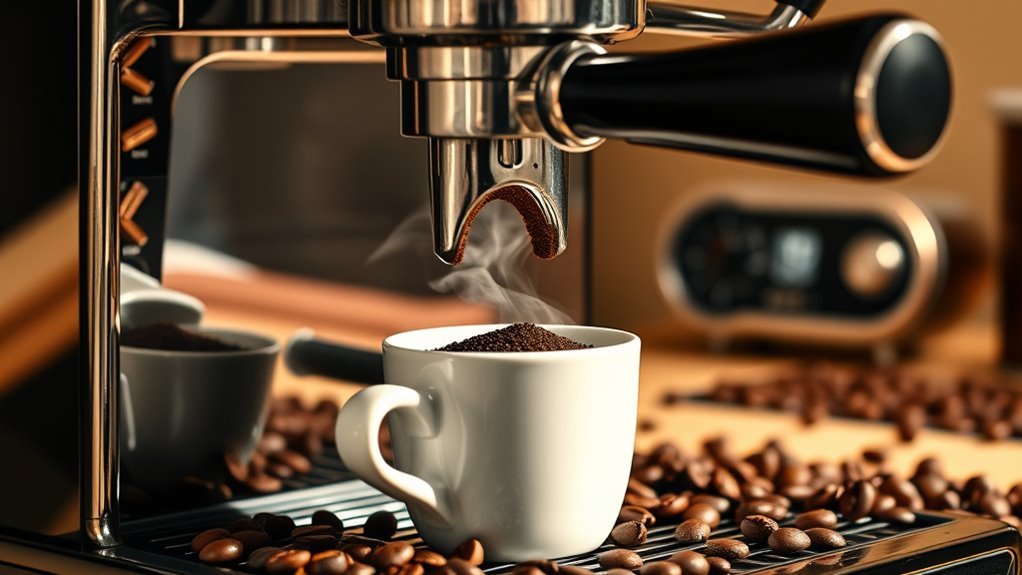
To brew regular coffee using your espresso machine, you’ll need to adjust the grind size and control the water temperature effectively. A coarser grind is crucial for regular coffee, allowing for ideal extraction without bitterness. Additionally, maintaining the right water temperature guarantees you achieve a balanced flavor profile, distinct from espresso.
Grind Size Adjustment
When brewing regular coffee with an espresso machine, adjusting the grind size is vital for achieving the desired flavor profile and extraction. The grind consistency and grind range can greatly impact your brew, so it’s important to find the right balance.
- Use a coarser grind to prevent over-extraction and bitterness.
- Experiment within the grind range to discover the ideal setting for your coffee beans.
- Maintain consistent grind size for uniform extraction and flavor.
Aiming for a grind that’s slightly coarser than traditional espresso will allow the water to flow through more evenly, enhancing the overall taste. With these adjustments, you can reveal a new dimension of flavors while brewing regular coffee in your espresso machine.
Water Temperature Control
Controlling water temperature is essential for brewing regular coffee with an espresso machine, as it directly affects extraction and flavor. Ideally, you want to maintain temperature stability throughout the brewing process, aiming for around 195°F to 205°F. If the water’s too hot, you risk over-extraction, leading to bitter notes; too cool, and under-extraction occurs, resulting in a sour taste.
To achieve best results, monitor your brew time closely; typically, a longer brew time can compensate for slightly lower temperatures. Adjusting both your water temperature and brew time will allow you to harness the espresso machine’s capabilities while crafting a flavorful cup of regular coffee. Embrace this freedom to experiment, and you’ll discover your perfect brew.
Choosing the Right Coffee Beans
Choosing the right coffee beans is essential for brewing a satisfying cup of regular coffee in an espresso machine, as the quality and flavor profile of the beans greatly influence the final result. You’ll want to take into account various factors to guarantee a great brew:
- Coffee bean origins: Different regions produce beans with unique flavors and characteristics. Explore beans from South America, Africa, and Asia for diverse profiles.
- Roast levels: Light roasts retain more acidity and fruity notes, while dark roasts provide a bold, rich flavor. Choose based on your taste preference.
- Freshness: Always opt for freshly roasted beans, as they considerably enhance the flavor and aroma.
Adjusting Grind Size and Water Ratio
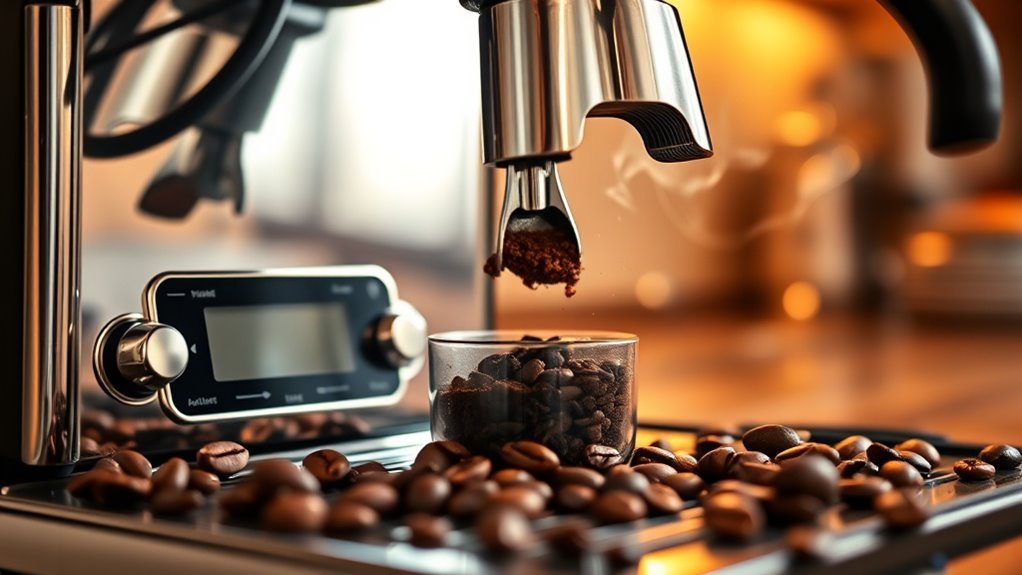
After selecting high-quality coffee beans, the next step involves fine-tuning the grind size and water ratio for ideal extraction. Achieving grind uniformity is vital; uneven grinds can lead to inconsistent flavors and extraction times. For regular coffee, a coarser grind is typically better than the fine grind used for espresso. Experimenting with the water ratio is equally important; a general rule of thumb is to use about 1:15 coffee to water. This balance helps guarantee that the coffee isn’t too weak or overly bitter. Keep adjusting both the grind size and water ratio until you find that sweet spot where flavors harmonize beautifully, providing you the freedom to enjoy a superb cup brewed from your espresso machine.
Exploring Alternative Brewing Methods With Espresso Machines
While many people associate espresso machines solely with brewing rich, concentrated shots of espresso, they can also be versatile tools for exploring various alternative brewing methods. This espresso versatility allows you to tap into your coffee creativity and experiment with flavors and techniques.
Consider trying these alternative methods:
- AeroPress-style brewing: Use your machine to push hot water through coffee grounds, mimicking the AeroPress.
- Cold brew extraction: Utilize the espresso machine to create a concentrated cold brew by adjusting water temperature and flow.
- Steamed milk infusions: Experiment by infusing flavored syrups or spices while steaming milk, adding a unique twist to your beverages.
With these methods, you can transform your espresso machine into a multifaceted brewing powerhouse, expanding your coffee repertoire.
Tips for Enhancing Your Coffee Experience

To truly elevate your coffee experience, it’s essential to focus on the finer details that can make a significant difference in flavor and enjoyment. Start by experimenting with various brewing techniques; each method extracts unique flavors from the beans. For instance, try adjusting water temperature and grind size to see how they affect the taste. Engage in coffee tasting sessions, where you can compare different beans side by side, honing your palate and discovering subtle notes. Keep your equipment clean and use filtered water to avoid unwanted flavors. Finally, consider the freshness of your coffee; freshly roasted beans will always yield a superior cup. By paying attention to these details, you’ll reveal a richer, more satisfying coffee experience.
Frequently Asked Questions
Can I Use Pre-Ground Coffee in an Espresso Machine?
Yes, you can use pre-ground coffee in an espresso machine, but the quality matters. Pre-ground coffee often lacks the freshness and ideal grind size needed for espresso, which typically requires a finer espresso grind. If you choose pre-ground, make sure it’s high quality to enhance flavor extraction. However, for the best results, you’ll want to grind your beans just before brewing, giving you the freedom to enjoy a richer, more flavorful espresso.
How Long Does It Take to Brew Regular Coffee in an Espresso Machine?
Think of your espresso machine as a clockwork marvel, each part working in harmony to create the perfect brew. When it comes to brewing regular coffee, you’ll find the process can take around four to six minutes. This is longer than espresso extraction, which happens in mere seconds. The brewing time allows for a fuller flavor profile, so don’t rush it; embrace the art of coffee-making and enjoy the freedom of choice.
Is an Espresso Machine Suitable for Large Coffee Batches?
An espresso machine typically isn’t suitable for large coffee batches due to its limited espresso capacity. While it excels at producing rich, concentrated shots, trying to brew more than a few servings can compromise coffee strength and flavor consistency. If you’re seeking to enjoy multiple cups, a traditional drip coffee maker or a French press might be better suited for your needs, allowing for larger quantities without sacrificing quality.
Can I Make Cold Brew Coffee With an Espresso Machine?
You can’t make traditional cold brew coffee with an espresso machine, but you can explore creative cold brew techniques using espresso’s versatility. For instance, you might brew a concentrated espresso shot and mix it with cold water and ice to mimic the cold brew flavor. This method won’t replicate the slow steeping process of true cold brew but can yield a revitalizing coffee experience, allowing you to enjoy espresso in a chilled format.
What Is the Best Water Temperature for Brewing Regular Coffee?
Isn’t it ironic how the perfect cup of coffee hinges on something as simple as water temperature? For brewing regular coffee, you’ll want your water between 195°F to 205°F. This temperature range enhances extraction and balances the coffee flavors. If it’s too hot, you risk bitterness; too cool, and the brew may taste flat. Mastering these brewing techniques lets you enjoy a cup that’s not just coffee, but an experience.
